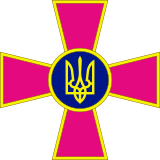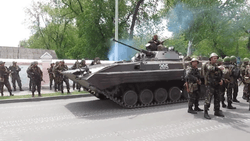Ukrainian Ground Forces
| Ukrainian Ground Forces Сухопутні Війська України | |
|---|---|
 Emblem of the Ukrainian Ground Forces | |
| Active |
1919–1922 12 December 1991–present |
| Size |
260,000 Active personnel (2016)[1] 80,000 Reserve (2016)[2] |
| Headquarters | Kyiv |
| Anniversaries | Army Day (12 December, anniversary of the 1991 formation of the Ground Forces).[3] |
| Engagements |
Kosovo Force (KFOR) Iraq War War in Afghanistan (2001–present) 2014 Russian invasion of Crimea War in Donbass |
| Commanders | |
| Current commander | Lieutenant General Serhiy Popko[4] |
| Insignia | |
| Ground Forces Ensign |
 |
| Flag of Ukraine |
 |
The Ukrainian Ground Forces (Ukrainian: Сухопутні Війська ЗСУ, Sukhoputni Viys’ka ZSU) are the land force component of the Armed Forces of Ukraine. They were formed from Soviet Ground Forces formations, units, and establishments, including three military districts (the Kiev, Carpathian, and Odessa Military Districts), that were on Ukrainian soil when the Soviet Union collapsed in 1990–92.
Since Ukraine's independence from the Soviet Union in 1991 Ukraine retained its Soviet-era army equipment and have not replaced nor upgraded it.[5] Also the Armed Forces have been systematically downsized since 1991 and as a result it was largely dilapidated in July 2014.[5] Since the start of the War in Donbass in April 2014 in eastern Ukraine Ukraine is upgrading its Armed Forces.[5][6][7] Its size of 129,950 in March 2014[8] had grown to 204,000 active personnel in May 2015.[1] In 2016 75% of the army consisted of contract servicemen.[2]
History
Prior to the October Revolution of 1917, three separate self-governing Ukrainian states existed on what is Ukraine today. Each of these states possessed armed forces. The largest of these, the Ukrainian People's Republic, itself comprised three separate regimes. The Ukrainian People's Army is an example of one of the early national armed forces. Other armed independence movements existed in the wake of both the First World War and the Second World War, and these armies each had distinct organisation and uniforms. These armed forces, and the independent Ukrainian homeland for which they fought, were eventually incorporated into the neighboring states of Poland, Soviet Union, Hungary, Romania and Czechoslovakia.[9]
Collapse of the USSR
The Armed Forces of Ukraine included approximately 780,000 personnel, 7,000 armored vehicles, 6,500 tanks, and 2,500 tactical nuclear missiles when they were established. However, the problem that Ukraine face was that while it had vast armed forces, it lacked a proper command structure. Therefore, on 24 August 1991, the Verkhovna Rada of Ukraine ratified the resolution of taking under its control, all military units of former Soviet Armed Forces, situated on the territory of Ukraine; and in turn the establishment of the Ministry of Defence of Ukraine.
Creation of the Ground Forces
| |||||||||||||||||||||||
Following the declaration of Ukrainian independence in 1991, Ukraine inherited the 1st Guards Army, 13th Army, 38th Army, two tank armies (the 6th Guards Tank Army and the 8th Tank Army), and the 32nd Army Corps (32-й Кенигсберский армейский корпус) at Simferopol. In addition, the 28th Guards Motor Rifle Division (MRD) and the 180th MRD were left in Ukraine, having been previously under the 14th Guards Army headquartered at Tiraspol in the Moldovan SSR. The post of commander of ground troops was designated in early 1992. By the end of 1992, the Kiev Military District disbanded, and Ukraine used its structures as the basis for the Ministry of Defence and the General Staff.[10] Between June and August 1993, the first redesignation of armies to army corps appears to have taken place.[11] While the chief of ground forces post had been created in early 1992, it was over two years before the first holder, Colonel General Vasily Sobkov, was appointed on 7 April 1994.[12] The legal framework for the Ground Forces was defined in Article 4 of the law 'On the Armed Forces of Ukraine.' At that time, the Ground Forces had no separate command body, and were directly subordinate to the Ukrainian General Staff.
The creation of the Ground Forces as a separate armed service was legally only put in train by Presidential Decree 368/96 of 23 May 1996, 'On the Ground Forces of Ukraine.'[13] That year both the Ground Forces Command was formed and the 1st Army Corps was reorganised as the Northern Territorial Operational Command (which became the Northern Operational Command in 1998). In 1997 the Carpathian Military District was reorganised as the Western Operational Command.
From 1992 to 1997, the forces of the Kiev MD were transferred to the Odessa MD, and the Odessa MD's headquarters moved to Donetsk.[14] A new 2nd Army Corps was formed in the Odessa MD. Armies were converted to army corps, and motor rifle divisions converted into mechanised divisions or brigades. Pairs of attack helicopter regiments were combined to form army aviation brigades.
President Leonid Kuchma revealed in a December 1996 speech that as many as 191 mechanised infantry and tank battalions were rated not ready, adding,"This is especially dangerous in the forward-based units securing the nation's borders."[15]
Reform
According to a plan promulgated in 2000 the Ground Forces were to reduce the number of troops from the then 300,000 to 240,000 by 2015, and an ultimate change from a partial conscript-based force to a fully professional military.[16] Even though the Armed Forces received little more than half of the Hr 68 million it was promised for reform in 2001, officials were able to disband nine regiments and close 21 local military bases.[nb 1]
In 2005–06, the Northern Operational Command was reorganised as Territorial Directorate "North". It was tasked with territorial defence, mobilisation training, and preparation of reserves.[17][nb 2]
From 1991 the Ukrainian Ground Forces bought its military equipment only from Russia and other CIS states, as well as locally producing some of their own equipment.[5][6] The defence industry in Ukraine produced equipment was not used to equip the Armed Forces prior to the War in Donbass (that started in April 2014[19]) but it produced only for export.[5]
Loss of Crimea
In the aftermath of the 2014 Ukrainian Revolution, Russian special forces in unmarked uniforms began surrounding Ukrainian military bases on the Crimea before capturing them individually using a mixture of attrition and threats.[20] Over the following weeks the Russian Armed Forces consolidated control of the peninsula and established road blocks to cut off the possibility of Ukraine sending reinforcements from the mainland.[21] By the end of March, all remaining Ukrainian troops were ordered to pull out of Crimea.[22] The Ukrainian Army was considered to be in a poor state during and after the annexation with only 6,000 of its troops ready for combat and many of its vehicles lacking batteries.[23] (According to February 2016 official Ukrainian figures) after Russia's annexation 6.000 of the pre-annexation 20.300 people strong Ukrainian army personnel left Crimea.[24]
War in Donbass
Military Training and Education Centers


Training in 2006 was aimed at developing mobility and combat readiness of the forces.[25] The Ukrainian armed forces took advantage of the opportunities provided by UN exercises and exercises where Ukraine and NATO nations and other partners participated.[25][26]
Training resulted in 6,000 combat-ready troops in the spring of 2014 of Ukraine's (then) 129,950 active military personnel.[23][27] In 2016 the Ukrainian army had more than 200,000 combat-ready soldiers of its 260,000 active personnel.[1][28]
In 2015 Ukraine, the United States, the United Kingdom and Canada established the Joint Multinational Training Group – Ukraine (JMTG-U) and they set up three new training sites, in Khmelnytskyi, Yavoriv and Kamianets-Podilskyi.[28]
Education Centers
In 2007 the system of exercise/training ranges was optimized, decreasing their number and providing a specialized role.[29]
Schooling Occurs at:
- 169th Training Center - (Desna / 50°55'35"N 30°45'27"E) - Home to army initial training, for all personnel entering the Army, it is also houses the 169th Teaching Brigade which homes in the tactics and skills of tankers and mechanized/motorized infantrymen.
- Hetman Petro Sahaidachny Ground Forces Academy - (Lviv / 49°49'28"N 24°1'2"E) - It is an academy for all officer cadets seeking a commission, an equivalent of the American West Point and British Sandhurst.
- National Defense University of Ukraine "Ivan Chernyakhovsky" - (Kiev / 50°25'57"N 30°27'52"E) - Teaches specialization like foreign languages, book keeping, cryptology, study of armaments, logistics, etc.
- Ivan Bohun Military High School - (Kiev / 50°25'24"N 30°32'43"E) - A JROTC style boarding school which has curriculum identical to Ukraine's public schools with added focus on military teachings and discipline.
- Korolev Signals Institute - (Zhytomyr / 50°17'6"N 28°36'54"E) - Teaches theory and practice of electromagnetic waves and their uses in communication, radio location, eavesdropping, and jamming.
- Military Institute of Telecommunications and Information Technologies - (Kiev / 50°25'18"N 30°33'25"E) - Teaches subjects of: Computer Science, Systems engineering, Telecommunications, Security Information and Communication Systems, Systems of technical protection of information, Electronic military administration.[30]
- Odessa Artillery Academy
While Training Ranges are:
|
|
|
Branches of the Ground Forces
Armoured and mechanised forces
Mechanised Infantry and armoured forces are the primary components of the Ukrainian Ground Forces. Their primary objectives in case of war are capturing and holding targets, maintaining positions, defending against attack, penetrating enemy lines and defeating enemy forces.
The mechanised and armoured forces are equipped with T-64[31] and T-64BM "Bulat"[32] main battle tanks; BTR-4, BTR-60, BTR-70 and BTR-80, wheeled armored personnel carriers and BMP-1, BMP-2 and BMD-2 infantry combat vehicles.
Since the fall of the Soviet Union, a large number of the previous Soviet mechanised formations on Ukrainian soil have been disbanded – the IISS says totals have dropped from 14 divisions, in 1992, to two divisions, six brigades, and one independent regiment in 2008.[33] Today, all mechanised and armoured formations are called brigades. However, some former divisions remain near division strength.
Current formations include:
- 1st Armored Brigade – Honcharivske[34] Chernihiv Oblast, Ukraine
- 17th Armored Brigade – Kryvyi Rih[35] Dnipropetrovsk Oblast, Ukraine
- 30th Mechanised Brigade - Novohrad-Volynskyi Zhytomyr Oblast
Disbanded armoured formations include:
- 17th Guards Tank Division[36][37] – 17th Armored Brigade – reformed into brigade by 2003
- 23rd Training Tank Division – 6065th Storage Base since 1987[37]
- 30th Guards Tank Division[37] – 30th Tank Brigade – July 30, 2004 reformed into 30th Mechanised Brigade
- 41st Guards Tank Division – 5193rd Storage Base since 1989[36][37]
- 42nd Guards Tank Division – 5359th Storage Base since 1990[36][37]
- 48th Guards Training Tank Division – 169th District Training Centre[36][37]
- 117th Guards Tank Division – 119th District Training Centre[37]
Mountain infantry Brigade
The Ukrainian Ground Forces also include two mountain infantry brigades.
Airmobile Forces and Army Aviation
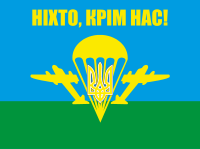

Army Aviation, having to cover troop movements, is by far the most maneuverable branch of the army, intended to conduct the operations under all sorts conditions of combat arms procedures. Among the priorities of the Ukrainian army aviation's units is to provide reconnaissance, attack enemy weapon systems, provide equipment and human resources, give tactical fire support during an offensive or counterattack, land airmobile troops, and to deliver combat weapons and personnel at the specified areas and execute other main tasks. There are two units: the 3rd Army Aviation Regiment and 7th Army Aviation Regiment. They are equipped with Mil Mi-8 and Mi-24 helicopters, and their variants.[38]
The Ukrainian Airmobile Forces serve as the quick response units of the army. Airmobile forces' structure consists of formations and elements of the army and the army aviation. These units are well trained for offensive activities behind enemy lines. The airmobile forces are in constant combat readiness and base their battle plan on high mobility.[39] The airmobile forces consist of four airmobile brigades and an airborne brigade.[40] The 25th Airborne and 45th Airmobile Brigades were previously grouped into the 1st Airmobile Division but the division was disbanded in 2003.
Headquarters of the Airmobile Command is located in Zhytomyr. It includes the following units:[40]
- 25th Airborne Brigade (Ukraine)
- 45th Airmobile Brigade (Ukraine)[41]
- 79th Airmobile Brigade (Ukraine)
- 80th Airmobile Brigade (Ukraine)
- 81st Airmobile Brigade (Ukraine)
- 95th Airmobile Brigade (Ukraine)
Rocket and Artillery Troops

Rocket Forces and Artillery troops of the army consist of formations of tactical missiles, self-propelled artillery, howitzers, jet-propelled and anti-tank artillery, artillery reconnaissance units, of mortar units and of units of anti-tank missiles. These forces operate as support for other army formations, and are therefore obliged to destroy enemy human resources, tanks, artillery, anti-tanks weapons, aircraft, air defence equipment, and other important objects during the combat arms operations. Rocket and artillery troops are equipped with: missile complexes of operational-tactical and tactical missiles; Multiple rocket launcher rocket systems, such as the Smerch, Uragan, Grad; also, Giatsint, Pion, Akatsiya, Gvozdika howitzers; and, Konkurs, T-12 antitank gun anti-tank weapons.
Previously the 1st Rocket Division was active at Хмельницкий, formed on the basis of the former Soviet 43rd Rocket Army. It had two to three rocket brigades (19-Хмельницкий, 46 или 199- Gchovka, 107-Кременчуг) with 54–56 Скад/Scud. It was active in 2003,[42] but disbanded in 2004.[43] In addition, previously the 461st Rocket Brigade (рбр) Славута, 13 АК ЗОК, the 459th Rocket Brigade (рбр) at Белая Церковь-8 АК,СОК- Точка- расформирована в 2004, 123 рбр- Контоп-СОК, Точка, 107 рбр (Kremenchug) (Tochka), and the 159th Rocket Brigade (рбр) (Кіровоград) were active.[43]
Army Air Defence
The Army Air Defence units are responsible for covering troops against enemy air attacks anywhere on the battlefield, and while in combat. The Ukrainian Ground Forces army air defence branch is equipped with a variety of effective surface-to-air missile systems of division level and anti-aircraft missile and artillery complexes of regiment level. Regiment level units are characterized by their high rate of fire, vitality, maneuverability, and capability of action under all conditions of modern combat arms operations. Surface-to-air missile systems and complexes of division level are characterized by their long range and firepower and are equipped with surface-to-air missile complexes;S-300V,Osa, Buk, Buk-M1 and Tor. While anti-aircraft missile and artillery complexes that are of regiment level are equipped with the Tunguska-M1, Igla MANPADS system, Strela, and Shilka anti-aircraft missile systems.[44] While the army's only separate radar system, meaning it isn't a part of any anti-aircraft system, is the Ukrainian Kolchuga-M. It was designed sometime between the years 1993–1997, the system is said to be one of the most (if not the most) advanced passive sensors in the world, as it was claimed to be able to detect stealth aircraft.[45]
Structure
2015 structure of the Ukrainian Ground Forces after the reorganization caused by the Donbass War. It built and expanded on the 2011 structure.[46]

Location of Ukraine Ground Forces combat brigades
Red – Airborne, Green – infantry, Blue - helicopter
Gold – armoured, Brown – artillery, Pink – rocket

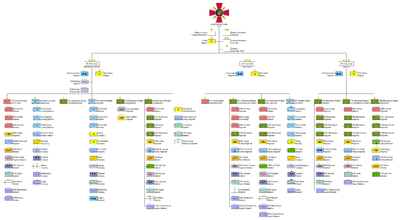
- Land Forces Command, Kyiv.[48][49]
- 15th Guards Rocket Artillery Regiment, Drogobych[48][49]
- 27th Artillery Brigade, Sumy[48][49]
- 43rd Artillery Brigade, Pereiaslav-Khmelnytskyi[48][49]
- 19th Missile Brigade, Khmelnytskyi[48][49]
- 12th Army Aviation Brigade, Novyi Kalyniv[48][49]
- 11th Army Aviation Brigade, Kherson[48][49]
- 16th Army Aviation Brigade, Brody[48][49]
- 18th Army Aviation Brigade, Poltava[48][49]
- 48th Separate Engineer Brigade, Kamianets-Podilskyi[50]
- 101st General Staff Security Brigade, Kyiv[51]
- 169th Training Centre (Ukraine), Desna[48][49]
- 6th Artillery Training Regiment, Divychky[49]
- 1st President Guard Regiment, Kyiv[48][49]
- 3rd Special Forces Regiment, Kropyvnytskyi[48][49]
- 8th Special Forces Regiment, Khmelnytskyi[48][49]
- 704th Separate Regiment of CBRN defense, Sambir[48][49]
- 808th Pontoon Bridge Regiment, Bilhorod-Dnistrovskyi[50]
- Operational Command "West", Rivne[48][49]
- 10th Mountain Brigade, Chernivtsi[48][49]
- 14th Mechanized Brigade, Volodymyr-Volynskyi[48][49]
- 24th Mechanized Brigade, Yavoriv[48][49]
- 80th Airmobile Brigade, Lviv[40]
- 128th Mountain Brigade, Mukacheve[48][49]
- 44th Artillery Brigade, Ternopil[48][49]
- 55th Signals Brigade, Rivne[48][49]
- 703rd Engineer Regiment, Sambir[48][49]
- 136th Reconnaissance Battalion, Rivne[48][49]
- Operational Command "North", Chernihiv[48][49]
- 1st Tank Brigade, Honcharivske[48]
- 30th Mechanized Brigade, Novohrad-Volynskyi[48][49]
- 58th Mechanized Brigade, Konotop[48][49]
- 72nd Mechanized Brigade, Bila Tserkva[48][49]
- 95th Airmobile Brigade, Zhytomyr[40]
- 26th Artillery Brigade, Berdychiv[48][49]
- 12th Engineer Regiment, Novohrad-Volynskyi[48][49]
- 20th Electronic Warfare Regiment, Zhytomyr[48][49]
- 93rd Signal Regiment, Zhytomyr
- 1129th Anti-aircraft Artillery Regiment, Bila Tserkva[48][49]
- 54th Reconnaissance Battalion, Novohrad-Volynskyi[48][49]
- Operational Command "South", Odessa[48][49]
- 28th Mechanized Brigade, Chornomorske[48][49]
- 56th Mechanized Brigade, Melitopol[48][49]
- 57th Mechanized Brigade, Kropyvnytskyi[48][49]
- 59th Mechanized Brigade, Podilsk[48][49]
- 79th Airmobile Brigade, Mykolaiv[40]
- 40th Artillery Brigade, Pervomaisk[48][49]
- 1039th Anti-aircraft Artillery Regiment, Hvardiiske[48][49]
- 130th Reconnaissance Battalion, ?[48][49]
- Operational Command "East", Dnipropetrovsk[48][49]
(as the result of War in Donbass, a split from the OC "South")- 17th Tank Brigade, Kryvyi Rih[48][49]
- 25th Airborne Brigade, Hvardiiske[40]
- 53rd Mechanized Brigade, Sievierodonetsk[48][49]
- 54th Mechanized Brigade, Bakhmut[48][49]
- 81st Airmobile Brigade, Kostiantynivka[40]
- 92nd Mechanized Brigade, Chuhuiv[48][49]
- 93rd Mechanized Brigade, Cherkaske[48][49]
- 55th Artillery Brigade, Zaporizhia[48][49]
- 121st Signal Brigade, Cherkaske[48][49]
- 107th Rocket Artillery Regiment, Kremenchuk[48][49][52]
- 91st Engineer Regiment, Okhtyrka[48][49]
- 74th Reconnaissance Battalion, Cherkaske[48][49]
- 129th Reconnaissance Battalion, Volodarske[48][49]
- 131st Reconnaissance Battalion, ?[48][49]
- 502nd Electronic Warfare Battalion, Cherkaske[48][49]
- 4th Army Corps Reserve[53]
- 14th Separate Tank Brigade
- 60th Separate Mechanized Brigade
- 61st Separate Mechanized Brigade
- 62nd Separate Mountain Brigade
Military ranks
- As a non-member state, NATO rank codes are not used in Ukraine, they are presented here for reference purposes only
In the new uniforms the Ukrainian Army unveiled in August 2016 the stars that traditionally adorn shoulder straps have been replaced by diamonds.[54] A new set of insignia are being adopted.
General and officer ranks
| NATO Code | OF-10 | OF-9 | OF-8 | OF-7 | OF-6 | OF-5 | OF-4 | OF-3 | OF-2 | OF-1 | OF(D) | Student Officer | |||
|---|---|---|---|---|---|---|---|---|---|---|---|---|---|---|---|
| 2009 Army |
 |
 |
 |
 |
No equivalent |  |
 |
 |
 |
|
 |
No equivalent |  | ||
| General of the Army of Ukraine | Colonel general | Lieutenant general | Major general | Colonel | Lieutenant colonel | Major | Captain |
|
Junior lieutenant | Officer kursant | |||||
- Rank insignia of the armed forces of Ukraine - shoulder boards on dress uniform (being adopted from 2016 - Ground Forces variant)
| NATO Code | OF-10 | OF-9 | OF-8 | OF-7 | OF-6 | OF-5 | OF-4 | OF-3 | OF-2 | OF-1 | OF(D) | Student Officer | |
|---|---|---|---|---|---|---|---|---|---|---|---|---|---|
| 2016 Army |
.png) |
.png) |
.png) |
.png) |
.png) |
.png) |
.png) |
.png) |
.png) |
.png) |
.png) |
-HOR-GSB(2015).png) |
 |
| General of the Army of Ukraine | Colonel general | Lieutenant general | Major general | Brigadier general | Colonel | Lieutenant colonel | Major | Captain | First lieutenant | Lieutenant | Khorunzhy | Officer cadet (Kursant) | |
NCO ranks and enlisted men
| NATO Code | OR-9 | OR-8 | OR-7 | OR-6 | OR-5 | OR-4 | OR-3 | OR-2 | OR-1 | |||||||||||||||||||||||||
|---|---|---|---|---|---|---|---|---|---|---|---|---|---|---|---|---|---|---|---|---|---|---|---|---|---|---|---|---|---|---|---|---|---|---|
1991 Army (abolished 2009, replaced with new ranks) |
 |
 |
 |
 |
 |
No equivalent |
 |
No equivalent |
 |
 | ||||||||||||||||||||||||
| Senior praporshchik | Praporshchik | Starshina | Starshy serzhant | Serzhant | Junior serzhant | Senior soldat | Soldat | |||||||||||||||||||||||||||
| NATO Code | OR-9 | OR-8 | OR-7 | OR-6 | OR-5 | OR-4 | OR-3 | OR-2 | OR-1 | |||||||||||||||||||||||||
|---|---|---|---|---|---|---|---|---|---|---|---|---|---|---|---|---|---|---|---|---|---|---|---|---|---|---|---|---|---|---|---|---|---|---|
2016 Army (in adoption stage) |
.png) |
.png) |
.png) |
.png) |
.png) |
.png) |
.png) |
.png) |
.png) |
.png) |
.png) | |||||||||||||||||||||||
| Chief master sergeant | Master sergeant | Sergeant First Class | Staff sergeant | Chief sergeant | Starshy serzhant | Serzhant | Corporal | Senior soldat | Soldat | Rekrut | ||||||||||||||||||||||||
| Ukrainian: | Головний майстер-сержант |
Майстер-сержант | Головний штаб-сержант | Штаб-сержант | Головний сержант | Старший сержант | Сержант | Капрал | Старший солдат | Солдат | Рекрут | |||||||||||||||||||||||
Equipment
Hardware
 |
 |
.jpg) |
 |
|||
Uniforms
The Ukrainian Army unveiled its new uniforms on 24 August 2016 (Independence Day of Ukraine).[54] The new uniforms are modeled on British military styles.[54] They also incorporate details from the uniforms worn by the Ukrainian People's Army.[54] The new cap includes an insignia of a Ukrainian Cossack grasping a cross.[54]
Deployment outside of Ukraine
Iraq
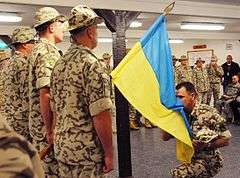
Ukraine deployed a sizable contingent of troops to the Iraq War, these were stationed near Kut. Ukraine's troop deployment was the second largest of all former Soviet states besides Georgia and they deployed more soldiers to the nation then many members of NATO such as Estonia, Latvia, and Lithuania. Ukraine also suffered the fifth highest casualty toll during the war, with only Polish, Italian, UK, and US forces suffering heavier losses.[55]
From 2003-2005 over 1,700 Ukrainian soldiers were deployed to Iraq, the third largest contingent at the time, they were designated to the 5th Mechanized Brigade (Ukraine), as in Ukraine's mission to Kosovo the troops deployed were contract soldiers and not conscripts. Ukraine began to severely draw down its troop levels in Iraq in 2005 due to mounting casualties and the political toxicity of the conflict. By 2005 only 876 soldiers, roughly half of the original contingent were deployed, by years end troop levels dropped to below 100. In 2008, one year before the official end of the US military mission President Viktor Yushchenko ordered all remaining troops deployed to Iraq returned home and Ukraine's mission to the nation officially over.[56]
Afghanistan
Since 2001 Ukraine allowed United States military cargo planes to fly over and refuel on Ukrainian soil on their way to Afghanistan. In 2007 Ukraine deployed a detachment of the 143rd De-mining Center of the Armed Forces of Ukraine to Afghanistan. Ukraine has kept a team of soldiers deployed to Afghanistan as part of ISAF since 2007, these mostly consisted of pilots, medical officers, and bomb disposal experts. Ukrainian pilots were responsible for training the pilots of the Afghan Air Force on the operation of several air craft as Afghanistan's forces consisted of many Soviet designed aircraft such as the Mi-17 with which Ukrainian troops were very familiar with. In 2013 the contingent of troops in Afghanistan totaled 26 troops. As of 2014 the Ukrainian contingent was further drawn down and the team included 8 bomb disposal experts and several medical officers.[57]
Kosovo
Ukrainian forces have also been deployed to Kosovo since 2000 as part of the 600 man Polish–Ukrainian Peace Force Battalion. In August 2014 Ukraine ended its mission to Kosovo due to the 2014 Russian invasion of Ukraine.[58]
Africa
Ukrainian peacekeeping forces have been deployed to the Democratic Republic of Congo, Liberia, Sudan and South Sudan and Cote d'Ivoire. Ukrainian forces have also been requested to take a more active role in the Northern Mali Conflict of 2012 in battling Islamic forces. One of the largest deployments is the 18th Separate Helicopter Unit of the Armed Forces of Ukraine which consisted of 160 servicemen and four Mi-24P helicopters and was deployed to the Democratic Republic of Congo in 2011.[59]
Military Decorations
 |
 |
 |
 |
 |
 |
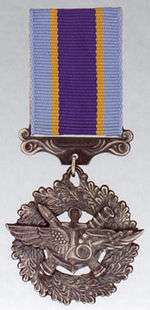 |
 |
|
Veterans
Ukraine provides combat veterans with various benefits. Ukrainians who have served in World War II, Soviet war in Afghanistan, or as liquidators at the Chernobyl disaster are eligible for benefits such as; a monthly allowance, discount on medical and pharmacy services, free use of public transportation, additional vacation days from work, having priority for retention in case of work layoffs, easier loan access and approval process, preference when applying for security related positions, priority when applying to vocation school or trade school, and electricity, gas, and housing subsidies. Veterans are also eligible to stay at military sanatoriums permitting there is space. Since gaining independence Ukraine has deployed troops to Kosovo, Iraq, and Afghanistan gaining a new generation of veterans separate from those who have served in the Soviet forces. Most recently the government passed a law extending veteran benefits to Ukrainian troops participating in the 2014 Russian invasion of Ukraine. Moreover, veterans from other nations who move to or reside in Ukraine may be eligible for some of the listed benefits, this provision was likely made to ensure World War II, Chernobyl, and Afghanistan veterans from other Soviet states who moved to Ukraine received similar benefits, however as Ukraine has participated in numerous NATO led conflicts since its independence it is unclear if NATO veterans would be extended these benefits.[60]
Veteran groups are not as developed as in the United States which has numerous well known national organizations such as the Veterans of Foreign Wars. World War II veterans, and even persons who have lived through the war are generally treated with the highest respect. Other veterans are not as well known. Ukrainian veterans from the Soviet War of Afghanistan are strikingly similar to the Vietnam veterans of the United States. The Soviet Union generally kept the public in the dark through the war, unlike in Vietnam where coverage was very high, Afghanistan is often labeled as a mistake by the Soviet Union and its successor states, the lack of media coverage and censorship through the war also ensured that many still remain unaware of their nations involvement in the conflict.[61] Despite Ukraine having the 3rd largest contingent of troops in Iraq in 2004 few also realize that their nation has many veterans of the Iraq war.
Soldiers that took part in the War in Donbass can receive free land plots.[62]
See also
Notes
- ↑ According to the State Program of the Ukrainian Armed Forces reform and development to 2005, the ground forces were to have the biggest ratio of personnel of all services (up to 54%). This ratio was to be based on the missions assigned to the armed forces, and also on the fact that the economy of Ukraine could not support any larger troop numbers. However, the ground forces still has priority in the number of personnel, weapons, military equipment development priorities and the development of their future systems, which were to correspond to modern warfare requirements. The ground forces were planned to closely coordinate their assignments with other army branches, engaging appropriate military arts and equipment. They were to also be involved in law enforcement activities during emergencies, dealing with consequences of technological and natural disasters, providing military assistance to other countries, engaging in international military cooperation activities (UN), and participating in international peacekeeping operations according to international agreements.
- ↑ It was reported on 27 July 2005 that '..[o]ver 70 per cent of planned work on [the] disbandment of the Ukrainian armed forces' Northern Operational Command has been completed,' according to the Defence Ministry's press service.[18]
References
Citations
- 1 2 3 Olga Rudenko (6 May 2014). "Thousands dodge Ukraine army in fight with rebels". USA Today. Retrieved 19 March 2016.
- 1 2 Ukrainian army composed of 75% contract servicemen - president, Interfax-Ukraine (24 August 2016)
- ↑ Culture Smart! Ukraine by Anna Shevchenko, Kuperard, 2006, ISBN 978-1-85733-327-5
- ↑ Poroshenko appoints ATO chief Commander of Land Forces, UNIAN (28 March 2016)
Poroshenko appoints ATO chief Popko as commander of ground forces, Interfax-Ukraine (28 March 2016) - 1 2 3 4 5 In the Army Now: Answering Many Why's, The Ukrainian Week (8 July 2014)
- 1 2 Ukraine must stop importing Russian weapons, switch to NATO standards, Interfax-Ukraine (18 December 2014)
- ↑ Poroshenko says military hardware will bring Ukraine's victory closer, Interfax-Ukraine (24 August 2016)
- ↑ Adam Taylor (3 March 2014). "Ukraine's military is far smaller than Russia's, but there are 3 reasons it might not be so easy to crush". The Washington Post. Retrieved 19 March 2016.
- ↑ Abbott, P. & E. Pinak Ukrainian Armies 1914–55 (Osprey Publishing Ltd., 2004), ISBN 1780964013, 9781780964010
- ↑ ANALYSIS: Ukraine adopts program for military reform, 03/02/1997
- ↑ See references at 6th Guards Tank Army and 6th Army Corps (Ukraine). On 1 December 1993, 8th Guards Tank Army became 8th Army Corps.
- ↑ Jane's Sentinel: Ukraine, 1994
- ↑ Yuriy Yurchnya, 'The Armed Forces of Ukraine,' DCAF, 2010, 89.
- ↑ Andrew Duncan, 'Ukraine's forces find that change is good,' Jane's Intelligence Review, April 1997, 162–3.
- ↑ Stephen D. Olynyk, Ukraine as a Post-Cold War Military Power, Joint Force Quarterly, Spring 1997, 93.
- ↑ http://merln.ndu.edu/whitepapers/Ukraine_Eng-2005.pdf , page 4 of 136
- ↑ Yurchnya, 2010, 91.
- ↑ Interfax-AVN, 'Ukrainian army's Northern Operational Command being disbanded,' Interfax-AVN military news agency web site, Moscow, in English 1152 gmt 27 Jul 05 via BBC Monitoring.
- ↑ Ukraine crisis timeline, BBC News
- ↑ "Kiev announces plans to withdraw Ukrainian troops from Crimea". The Guardian. Retrieved 31 January 2015.
- ↑ "Russia has sent 6,000 troops to Crimea says Ukraine". www.thejournal.ie. Retrieved 31 January 2015.
- ↑ "Ukraine orders all troops out of Crimea". CBS News. Retrieved 31 January 2015.
- 1 2 "Ukraine Battles to Rebuild a Depleted Military". Wall Street Journal. Retrieved 31 January 2015.
- ↑ (Ukrainian) After the annexation of Crimea left only 10% of staff SBU, Ukrayinska Pravda (February 8, 2016)
- 1 2 Ukrainian Armed Forces 2006 White Book p.25
- ↑ Ukrainian Armed Forces 2006 White Book p.26
- ↑ Explainer: How Do Russia's And Ukraine's Armies Compare?, Radio Free Europe (6 March 2014)
- 1 2 Ukrainian army struggling with its training system, Kyiv Post (14 September 2016)
- ↑ Ukrainian Armed Forces 2007 White Book p.42
- ↑
- ↑ (Ukrainian) Minister of Defence visits 1st Armored Brigade
- ↑ (Ukrainian) People's Army Magazine
- ↑ IISS Military Balance 1992/3, p 86, and Military Balance 2008, p 188
- ↑ (Ukrainian) Brigade in Honcharivske receives new tanks
- ↑ (Ukrainian) Training in the 17th Armored Brigade
- 1 2 3 4 Lenskiy
- 1 2 3 4 5 6 7 Feskov, p.106
- ↑ See Ukrainian Army Aviation
- ↑ "Военно-промышленный комплекс - Електронні вісті". Retrieved 30 October 2014.
- 1 2 3 4 5 6 7 "Високомобільні десантні війська" (in Ukrainian). Retrieved 1 February 2016.
- ↑ "New Airborne Brigade created in Ukrainian Army". UNIAN. 19 October 2016. Retrieved 20 October 2016.
- ↑ Ukrinform (2003-10-25). "London, UK-based Institute for Strategic Studies appraises Ukrainian Armed Forces' personnel as 295,500-strong". Ukrainian Government. Retrieved 21 November 2012.
- 1 2 http://www8.brinkster.com/vad777/sng/ukraine/ukraine_grand_force-dislokazia.htm, accessed November 2012.
- ↑ Structure of Ukrainian Armed Forces
- ↑ http://thereliant.blogspot.com/2006/09/in-focus-kolchuga-esm-system.html
- ↑ "Ukrainian Armed Forces White Book 2011" (PDF). Retrieved April 10, 2013.
- ↑ Структура Сухопутних військ ЗС України
- 1 2 3 4 5 6 7 8 9 10 11 12 13 14 15 16 17 18 19 20 21 22 23 24 25 26 27 28 29 30 31 32 33 34 35 36 37 38 39 40 41 42 43 44 45 46 47 48 49 50 51 52 53 54 55 Dovbaka Nicholas Ihorovych. "National defense" (in Ukrainian). Retrieved 1 February 2016.
- 1 2 3 4 5 6 7 8 9 10 11 12 13 14 15 16 17 18 19 20 21 22 23 24 25 26 27 28 29 30 31 32 33 34 35 36 37 38 39 40 41 42 43 44 45 46 47 48 49 50 51 52 53 54 55 56 57 58 59 60 61 "Сухопутні війська" (in Ukrainian). Retrieved 4 July 2016.
- 1 2 "Головне управління оперативного забезпечення" (in Ukrainian). Retrieved 1 February 2016.
- ↑ "На территории 101-й бригады охраны Генштаба открыли "Аллею Славы" в честь погибших воинов" (in Russian). Retrieved 1 February 2016.
- ↑ http://poltava.to/news/25634/
- ↑ "Новостворена танкова бригада склала іспит на полігоні "ШИРОКИЙ ЛАН"" [New Tank Brigade passess test at training ground "Shyrokyi Lan"]. Ministry of Defence of Ukraine (in Ukrainian). 28 December 2015. Retrieved 2016-03-22.
- 1 2 3 4 5 Fashion statement: Ukrainian troops debut post-Soviet uniforms, The Washington Times (25 August 2016)
- ↑ "Ukraine withdraws last troops from Iraq". Reliefweb. 2005-12-05.
- ↑ "Ukrainians complete mission in Iraq". Army Times. 2008-11-08.
- ↑ "Українського контингенту Міжнародних сил сприяння безпеці в Афганістані". Ukraine Ministry of Defense. 2014-09-18.
- ↑ "Украина возвращает из Косово еще 100 миротворцев". Ukrinform. 2014-08-15.
- ↑ "Ukraine and Africa. Ukrainian Peacekeepers in Africa.". Borysfen Intel. 2014-08-15.
- ↑ "Benefits for the servicemen of the ATO". Харькова Тимохов. 2014-09-08.
- ↑ "Vietnam Veterans Against the War: THE VETERAN: Afghanistan Veteran Once Removed". Retrieved 30 October 2014.
- ↑ Soldiers participating in ATO get 863 land plots of 394 ha, 45% of petitions satisfied – land agency, Interfax-Ukraine (16 December 2014)
Sources
- International Institute for Strategic Studies, The Military Balance 2006.
- Yuriy Yurchnya, 'The Armed Forces of Ukraine,' Geneva Centre for DCAF, 2010.
Further reading
- Andrew Duncan, 'Ukraine's forces find that change is good,' Jane's Intelligence Review, April 1997, 162–165.
- Ben Lombardi, Ukrainian armed forces: Defence expenditure and military reform, Journal of Slavic Military Studies, Vol. 14, No. 3, version of record date 18 Dec 2007.
- James Sherr, Ukraine's Defence Reform: An Update, Conflict Studies Research Centre, 2002
External links
- The Army of the Armed Forces of Ukraine at the Ministry of Defence of Ukraine
- Armament of Ukrainian Ground Forces at the Ministry of Defence of Ukraine
- Ukraine: Ground Forces Equipment
- Vepr Assault Rifle
- The Ukrainian Army – uarmy.iatp.org.ua
- Analysis of the Ukrainian Security Policy
- Ukraine's strategic Defence bulletin
- May 2016 analysis by Glen Grant, a former colonel in the British Army and lecturer at Riga Business School about powerfulness of Ukraine’s armed forces, produced by 5 Kanal
